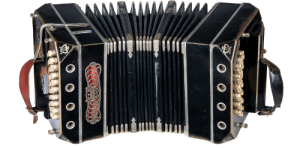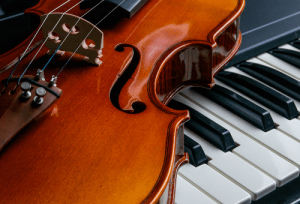 The Argentine Tango music which tends to be played at the majority of social dances is traditional music from the period between the 1930’s to mid 1950’s (often called Golden Age music). While it is possible to dance the tango to more modern music (known as Nuevo from the 1960’s onward, and ‘Alternative’ which is mainly non-tango music), the traditional tango music often contains more rhythmical and melodic choice on how to interpret the music in your dance. However we should also remember that this traditional music was the ‘pop’ music of that age, so maybe we shouldn’t get too precious about it 🙂
The Argentine Tango music which tends to be played at the majority of social dances is traditional music from the period between the 1930’s to mid 1950’s (often called Golden Age music). While it is possible to dance the tango to more modern music (known as Nuevo from the 1960’s onward, and ‘Alternative’ which is mainly non-tango music), the traditional tango music often contains more rhythmical and melodic choice on how to interpret the music in your dance. However we should also remember that this traditional music was the ‘pop’ music of that age, so maybe we shouldn’t get too precious about it 🙂
The dance and the music both developed together during the Golden Age, and each promoted and complimented the other. If you want to improve your musical interpretation of Argentine Tango, you need to listen to a lot of Golden Age music, and practice your tango dancing to such music.
When you listen to Tango music you should listen for three elements against which you can dance:
The walking or stepping beat
This is not necessarily the same as trying to step on every musical beat. In all tango music of any tempo, the first beat in each bar of music tends to be emphasised (a raising of volume or ‘zingyness’ to a note) and will be a stepping beat (beat 1).
A tango is often written in musical 4/4 time (4 musical beats to a bar of music), but we tend to step on beats 1 and 3 unless the tango is very slow in which case we can step on all 4 beats. Many older tango tunes, were written in 2/4 time, so for these we could step on both beats. For many tangos the stepping tempo is roughly 60 per minute (55- 65 pm), so if you are unfamiliar with a tune you can start your tango walk at this speed until you can identify the true walking beat.
In Milonga which is written in 2/4 time we could also step on both beats (but it’s usually faster than tango so you have to have quick feet :-)). In Vals, which is written in 3/4 time, we tend to step on beat 1.
All tango dancers of any level should aim for this basic level of musicality – to be able to step precisely in time with the walking beat.
The contra beat or syncopation
This would be any beat which would not normally be regarded as a walking beat, so in tango written in 4/4 time it would be musical beats 2 and 4. In vals it could be beats 2 and 3, but in milonga or older tango tunes it could be the ‘&’ half beat (i.e. the space between walking beats, as in ‘1 & 2’ where you are taking 3 steps in 2 beats).
This is the next level of musicality where you can use double-time walking, rebote (rebound) and traspie (‘stumble’) movements to syncopate. Most tango dancers should be able to use syncopation after some practice, and this level of musicality may be enough to take you through your social dancing lifetime as a reasonably good dancer, but…
The very best tango dancers learn to dance to the melody
So here we are not just interpreting the walking beats and performing syncopation, but we are also dancing to melodic elements in the tune, or to particular instruments, or to the voice of a singer. This also includes being attuned to the emotional emphasis expressed by the musicians and the singers.
Sometimes both dancers will interpret different elements of the melody, and so will look like they’re not quite in sync with each other. However even an asynchronous interpretation will look and feel good if the musical interpretation of each dancer is precise. Occasionally you will dance with a partner who hears the tune exactly the way you do, and interprets in a very similar way. Then you look to be in perfect sync.
Now you know what to aim for at each stage of your tango musical education
It’s important to try master each of these musical elements at the appropriate stage. Beginners/improvers need to master hearing and walking to the beat. Improvers/intermediates will need to hear the opportunities for syncopation and master their use. Finally advanced dancers will need to begin to know tunes so well that they can express the melody and emotion of a tune in their dance.
Like all tango training, musicality needs to be actively worked on. Just dancing and hoping that musicality will some day magically appear in your dance is going to take a long, long time. Actively listening to tango tunes will help you better identify the musical elements introduced above. Then you can practice to popular tunes until you dance better!
 If you have not had any formal music training and you are unsure about music beats, time signatures, bars etc. please read the previous article about musical terminology for a brief but hopefully useful run-down on the main terms you need to know.
If you have not had any formal music training and you are unsure about music beats, time signatures, bars etc. please read the previous article about musical terminology for a brief but hopefully useful run-down on the main terms you need to know.
In the next part of this series I will look at the structure of a typical tango orchestra, and how the beat is expressed in a traditional orchestra which very rarely uses drums!




